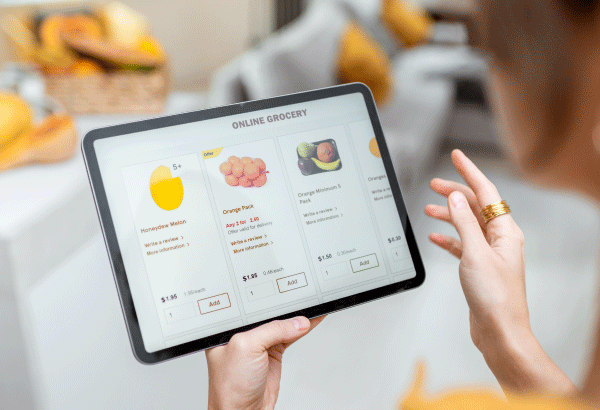- choosing among delivery models,
- improving order fulfillment speed and accuracy,
- providing accurate temperature-regulated storage.
Choosing among pick-up and delivery models
One of the first questions grocers need to answer is this: How will customers actually get the groceries they order online? Grocery retailers must decide if they want to create (or expand) their own pick-up and/or delivery system, hire a third-party delivery provider, or use a combination of their own infrastructure and a third-party delivery service.

Improving order fulfillment speed and accuracy
In the initial weeks of the pandemic, many shoppers tried to order groceries for pick-up, but found there wasn’t a time slot available for days. Even ship-to-home delivery became delayed from overnight to next day to next week, or longer. Wait time for grocery order fulfillment was clearly a point of customer frustration back then and fortunately, the vast majority of those issues have been resolved.
Still, many customers are finding that they are not able to pick-up their groceries at times that work best for them. Others report that when they arrive at their assigned time, they have to wait too long for their order, sometimes for more than an hour. In addition to problems with the availability and efficiency of pick-up, customers are also reporting frustration about missing items or that substitutions have been made without their approval. Clearly, grocers can improve the click and collect experience by providing efficient pick-up when it’s most convenient for customers and alerting them to substitutions and outages.
Providing accurate temperature-controlled storage
In standard retail, the vast majority of products can be shipped and delivered at ambient temperature; however, that is not the case for grocery retail. In grocery retail, products need be shipped and delivered at three different temperatures: ambient, refrigerated, and frozen. Market research has found that about 80% of online grocery orders can be stored and delivered at ambient temperature.
These items include canned goods, baking supplies like flour, paper products like toilet paper, etc. The remaining 20% of orders require storage at lower temperatures—12% needs refrigeration, and 8% needs to be kept frozen. (Interestingly, in the early weeks of the pandemic, these percentages were skewed more towards frozen and refrigerated items since people were preparing more of their meals at home.)
In the past, manufacturers of storage systems have tried remote pick-up solutions that fluctuated between two temperatures. But due to the thermal dynamic load of products being stored, changing the temperature of the storage medium created humidity and temperature issues that impacted freshness—and disappointed customers.
More recently, White Systems has developed a three-temperature solution called the UPAS™ (Unattended Pickup at Store) System, patent pending, to help grocers adapt to the rapidly changing market and increase in online orders. UPAS provides 24×7 accessibility with high throughput and delivery speeds on customer orders so grocers can maximize workforce efficiency. The fully customizable system offers unattended temperature-controlled customer pickup windows that are weather resilient and can be installed inside or outside of retail locations.
